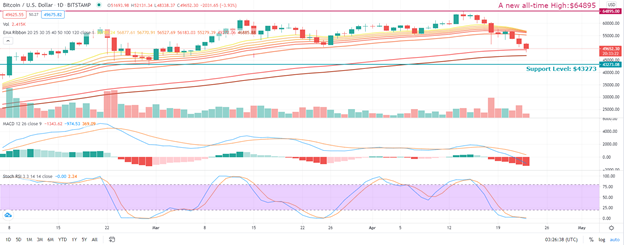After Bitcoin (BTC) hit its all-time high of $64,895 on April 16, the cryptocurrency retreated downwards, plunging to its lowest level since March. It is trading around $47, 931 at the time of writing.
A tweet by FXHedge attracted widespread attention last weekend, which claimed that the U.S. Treasury Department was cracking down on money laundering involving cryptocurrencies. Subsequently, BTC dropped more by than 15% over the weekend. Although there was a rebound in the next few days, the crypto market panic continued.
Affected by U.S. President Biden’s plan to nearly double the capital gains tax on the wealthy class, Bitcoin fell to its lowest level today, since March. It is currently trading at $48,338.
The advent of the U.S. tax season has made American investors in crypto assets panic. For those US investors who have held cryptocurrencies for more than one year, cashing out for selling digital assets will face the risk of high capital gains taxes. Take BTC as an example. In the past year, it has risen as high as 700% from $7,138 to $50,326 The Internal Revenue Service has also increased its taxation on the sale of encrypted assets. This may have caused many long-term investors to quickly sell in order to avoid capital gains tax.
Bitcoin Price Analysis

Source: BTC/USD Daily via TradingViewJudging from the daily candlestick, Bitcoin has fallen below its 50-day moving average price on the daily chart with the bullish momentum has faded.
At the time of writing, the bulls are actively pushing the price above the 100 day-Exponential Moving Average (120-EMA) of $49,286. If today’s closing price does not stand above the 100-EMA, then the bears will push Bitcoin’s price down to the 120-EMA of $46,897. A surge in the number of sell orders will push BTC below the 120-EMA of $46,897 support level and may trigger a more severe correction to the lowest point of this year – $43,273.
The bearish MACD index indicates that the bears are currently dominating the market. The Relative Strength Index reversed its direction towards the overselling zone, close to the zero axes. The stochastic Relative Strength Index may translate to a sharp declining trend toward the $43K level, as seen in late February this year, and it may consolidate around the zero axes for a period of time before the next segment takes off, which suggests that Bitcoin will likely experience a relative pullback.
Image source: Shutterstock
Credit: Source link






















